|
 |
|
 |
|
 |
 |
| |
16:9 in English: Deconstructing Expressionism: Antonioni’s Film of L’avventura
Af BERT CARDULLO
For Western society, theistically based and teleologically organized, the concepts of drama that derived substantially from Aristotle had sufficed for centuries. The cinema was born to that inheritance and, out of it, still produced fine works in the 1960s. But Michelangelo Antonioni (1912-2007) saw the dwindling force of this inheritance—“of an aging morality, of outworn myths, of ancient conventions,” as he put it in a statement accompanying the initial screening of L’avventura (The Adventure, 1960) at the Cannes Film Festival—and found new means to supplement it. He achieved, in other words, what many contemporary artists in his and other fields were seeking but not often with success: renewal of his art rather than repetition (fig. 1).
It is a commonplace that the most difficult part of an artist’s life in our time is not to achieve a few good works or some recognition, but to have a career, as Antonioni did: to live a life in art, all through one’s life, at the same time as one replenishes the life of that art. But since the beginning of the Romantic era and the rise of subjectivism, the use of synthesis - of selecting from both observation and direct experience, then imaginatively rearranging the results - has declined among serious artists, until by the 1960s art had taken on some aspects of talented diary-keeping. (The most obvious examples from the period are “confessional” poetry and “action” painting.) An artist’s life and internal experience have thus become more and more circumscribedly his subject matter, and his or her willingness to stay within them has become almost a touchstone of validity. This has led to the familiar phenomenon of the quick depletion of resources - all those interesting first and second works, and then the sad, straggling works that follow them - not to speak of the debilitation of art. The question is further complicated because the more sensitive a person is, the more affected that person is in our time by Ibsen’s Great Boyg - that shapeless, grim, and unconquerable monster from Peer Gynt (1867) who represents the riddle of existence - which increases the artist’s sense of helplessness, of inability to deal with such experience as he or she does have. |
|
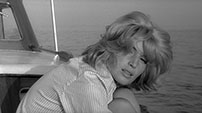
Fig. 1: Monica Vitti as observer in L’avventura (The Adventure, 1960). |
|
| |
One such response from the 1960s - the decade during which Antonioni made his great trilogy, which includes L’eclisse (Eclipse, 1962) in addition to L’avventura and La Notte (The Night, 1961) - was that of Jackson Pollock, Hans Hofmann, and their kin, who were exponents of dissatisfaction rather than re-creation. Another was that of French anti-novelists like Alain Robbe-Grillet and Nathalie Sarraute, who, in their frustration with the limits of the conventional novel, asked readers to share their professional problems rather than be affected as readers (fig. 2). Bertolt Brecht, for his part, jostled the traditional drama healthily (ironically, more so subsequent to his death in 1956 than prior to it), but his theater was didactic and aimed towards a different godhead - a temporal one that now seems sterile to many. The so-called Theater of the Absurd faced reality rigorously and even poetically, but such a theater of images and few or no characters was limited to disembodied effects - and each of its playwrights (Ionesco, Beckett, Pinter) seemed to have one reiterated effect.
In films, too, the avant-garde - Man Ray, Jean Cocteau, and many others to follow - had tried to find new methods or forms; but they, too, concentrated so much on the attempt that they neglected to communicate much content. A more conventional artist like Ingmar Bergman felt the spiritual discontent of the 1960s as keenly as anyone, but his films from this period, for all their superb qualities, exemplify Buck Mulligan’s line to Stephen Dedalus in James Joyce’s Ulysses: “You have the cursed jesuit strain in you, only it’s injected the wrong way” (Ch. 1, line 209). The fountainhead of these Bergman films, that is, may be mysticism, but his asking whether the God-man relation was still viable seemed anachronistic - to put it mildly - by the second half of the twentieth century. Antonioni himself seemed, around the same time, to have answered that question in the negative; to have posited that human beings must learn self-reliance or crumble; to have begun hoping for the possibility of hope.
Nonetheless, Antonioni seemed to be forging a miracle, albeit of the secular kind: finding a way to speak to his contemporaries without crankily throwing away all that went before and without being bound by it. He was re-shaping the idea of the content of film drama by discarding ancient and less ancient concepts, by re-directing traditional audience expectations towards immersion in character rather than conflict of character, away from the social realism of his neorealist forbears and toward what can be called “introspective realism” - in order to see just what remained inside the individual after the nightmare of World War II (with its Holocaust and atomic weaponry) and all the political as well as economic upheavals that followed. Particularly in the trilogy but also in the film immediately following it (and his first one in color), Il deserto rosso (Red Desert, 1964), Antonioni arrived at a profoundly cinematic mode of expression or exposition - a mode glimpsed earlier, significantly, in American postwar film noir - in which every aspect of style, of the purely visual realm of action and object, reflects the interior state of the characters (fig. 3).
Coherence, unity, connection between interior self and exterior reality are no longer sustained by this world of commerce and utility, so its inhabitants have to establish for themselves the very ground of their behavior. What is mistaken for boredom in Antonioni’s characters, then, is actually a condition of radical disjunction between personality and circumstance. For a vital connection has been broken: the physical world has been dispossessed of the inherited meanings and principles according to which we had previously motivated our lives and structured its psychic as well as moral events. In such a world the idea of a “story,” in the sense of a progressive tale leading from a fixed starting point to a dénouement that “settles” something or solves some problem, no longer has any use and is in fact inimical to the way this world is actually experienced.
The way people experience the world was undergoing a similar change in Germany during the period when dramatic and cinematic expressionism emerged. As David A. Cook has described,
A wave of revolutionary excitement . . . swept over the whole of Germany in the wake of [World War I]. Germany’s crushing defeat resulted in a complete rejection of the past by much of the intelligentsia and a new enthusiasm for the progressive, experimental, and avant-garde. Expressionism, a movement that began in German painting, music, architecture, and theater before the war in reaction to the pervasive naturalism of late-nineteenth-century art, found a large public during the revolutionary Aufbruch [awakening]. Unlike naturalism, which represented objective reality, Expressionism attempted to represent the artist’s subjective feelings in response to objective reality. It employed a variety of non-naturalistic techniques, including . . . abstraction and distortion, to achieve this end. (91)
The problem with expressionism in drama and film, as one might guess, is precisely its sometimes extreme subjectivity, which can become so subjective or personal as to hinder interpretation. In any event, the expressionist experiment in film (represented in Germany by such pictures as The Cabinet of Dr. Caligari [1920], The Student of Prague [1913, 1926], The Golem [1920], Warning Shadows [1923], and Metropolis [1927]) largely ceased with the advent of sound: the word ultimately destroyed cinematic expressionism because characters talking aloud at skewed angles, amid painted sets, and under artful lighting were somehow not only unreal, but also ridiculous. (The word also ultimately destroyed German dramatic expressionism onstage - as represented by the works of Ernst Toller, Georg Kaiser, Walter Hasenclever, Paul Kornfeld, Reinhard Sorge, and even the early Brecht - because its shrill, repetitive language tended to lack variety, subtlety, and ambiguity: in a word, richness.)
Antonioni’s Introspective Realism
Antonioni’s answer to the problem of expressionism’s extreme subjectivity, as I have suggested, was introspective realism, or a combination of realism and expressionism that places just as much emphasis on objective reality as on subjective feeling (unlike Italian neorealism, which was itself a reaction against the pre-World War II cinematic style that used polished actors on studio sets, fatuous themes, and artificial, gratuitously resolved plots). Let me now use L’avventura as a prime instance of Antonioni’s unique cinematic style - a style whose connection with expressionism goes unremarked by all other critics (noted in the bibliography) of this director’s work. The very structure of L’avventura reminds one of that of German Expressionist drama, which frequently consists of a series of tableaux or stations depicting the hero’s passage through places and events that externally have little, if any, connection. The title L’avventura alone declares that the film will be about such a passage, in the form of an adventure or a quest. That quest is initially for diversion or excitement, in Anna and Claudia’s trip to Sandro’s apartment (Station 1) and in the boat trip to the rocky island (Station 2) off the coast of Sicily, where Antonioni shoots his characters traversing the terrain and searching the ancient ruins. |
|
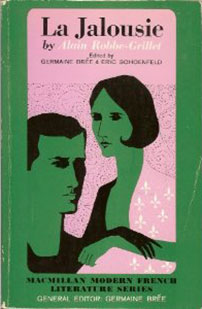
Fig. 2: Alain Robbe-Grillet’s novel La Jalousie (1957) is a prime example of a nouveau roman.
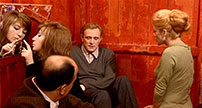
Fig. 3: Il deserto rosso (1964) forges interior self and exterior reality. |
|
| |
The quest soon becomes to find Anna (fig. 4), however, who has disappeared from the island. Then it quickly turns into Sandro and Claudia’s search for a relationship and her unconscious search for self. Thus, although the two are still ostensibly searching for Anna, their stop in an empty town square (Station 4) before going to Noto (where Anna has supposedly gone by bus); their scenes in Noto (Station 5) in the paint shop, the bell tower, and their room; and their scenes in the expensive hotel in Taormina (Station 6), as well as Claudia’s experiences at the Princess’s villa (Station 3), come outwardly to have little, if any, relation. These sequences are really about Claudia’s growth and her growing to love Sandro, and they are important less for themselves, less for the action they would stimulate in a linear narrative, than for what they reveal about the characters.
The same can be said in retrospect for the scenes at Sandro’s apartment and on the island itself: externally, they have little connection. One expects Anna and Claudia to pick Sandro up quickly and go off to an island paradise for fun and relaxation. Instead, Anna and Sandro delay departure by having sex, then they, Claudia, and friends stop at an island where it would be impossible to have a good time in the conventional sense - there is no beach, no hotel, there are no inhabitants, and the nearby islands are also covered with rock (fig. 5-6). Like the sequences that follow, these two are important, then, less for themselves, for the action that might grow integrally out of them, than for what they reveal about the characters and what the characters reveal about themselves to Claudia.
J. M. Ritchie, among others, has noted that in German Expressionism there is constant emphasis on portraying the essence of a situation or character, its deeper image instead of its mere surface appearance (15). Thus the barrenness of the island and its volcanic rock, under which an ancient civilization lies buried, are symbols, externalizations, of the sterility and callousness of modern civilization, which is epitomized by the wealthy boaters. It is no accident that Raimondo drops the ancient vase (found by a diver) on the rocks when he turns to stare at Claudia and can show only mock sorrow for smashing it. The desolation of the town they stop at on their way to Noto is itself a reflection of the emptiness of Sandro’s life and potentially of Claudia’s—she is the outsider in the film, since she is not rich like the rest of the party that originally sets out for the island, and consequently, as one separated from the others by class, she is somewhat akin to the spiritual outsiders of Expressionist drama. For its part, the tawdry opulence of the Princess’s villa and of the hotel in Taormina is a representation of the material wealth that idlers like Sandro use to cover their spiritual poverty, to fill up their barren lives.
Ritchie notes further that the dynamic, episodic structure of Expressionist drama mirrors the inner turmoil, the spiritual chaos, of the central figure, who often goes through a total moral transformation (18). The episodic structure of L’avventura is designed to mirror the inner turmoil, the spiritual chaos, of Anna; the impulsive search for love and self by Claudia; and the randomness as well as idleness of the lives of the rich. Inside this structure, the couples Sandro and Anna, Patrizia (the Princess) and Raimondo, Giulia and Corrado, Giulia and Raimondo, and Sandro and Gloria Perkins reflect the lovelessness and restlessness of the Italian rich. Again, Claudia is the outsider, the observer of the sexual encounters (or want of them) between these couples (as she is the outsider or observer at many other moments in the film, documented in the appendix). These couples are not reflections of her central position in the story, as they would be in an Expressionist drama; they are not her inner truth made outer, externalized. They are outer truth—the truth about the elite of Italian society—made inner, internalized by Claudia. |
|

Fig. 4: The search for Anna begins.


Fig. 5-6: The party make a stop at a rocky island that is an unlikely site to have a good time in the conventional sense. |
|
| |
She is thus an Expressionist protagonist in reverse - not least because Claudia is a female, whereas the protagonists of Expressionist drama and cinema are all male (with the possible exception of the leading female character in Robert Wiene’s film Genuine [1920]) until the style moves from Germany to America in the 1920s and we get Sophie Treadwell’s Machinal (1928), with its heroine named Helen. Where the Expressionist hero is active, Claudia is passive, getting her initiation into a way of life about which she has known little up to now. Claudia gets her knowledge less through action and conflict than through observation and introspection, less through her dramatic experience than through her visual one. Antonioni literally conveys her “undramatic” quest for love of Sandro and for insight into his social class by means of long takes and lengthy traveling shots of her searching over the extinct volcano, along the passageways of the Princess’s vast mansion, or through the corridors of the hotel in Taormina (fig. 7). Whereas time is compressed in Expressionist plays, as it is in most drama, in the service of action, time during these shots seems real and even extended: Antonioni’s intention is to make us experience something that approximates not merely the actual duration of Claudia’s search but also its psychological duration, and hence her frustration at not achieving fulfillment faster.
Where the Expressionist hero is often destroyed in the process of his transformation, Claudia survives to act on her knowledge, however tentatively, at the end of L’avventura. The German Expressionist hero would destroy bourgeois society and the bourgeois in himself, to create the “new man.” Instead of leaving Sandro with the knowledge that he is like all the others she has been observing, or instead of turning quickly to another “new” man, Claudia remains with him. Sandro looked for Anna and did not find her: she may have gone down into the sea and drowned. He looks for Claudia after she runs from the sight of him and Gloria Perkins making love, and he finds her on the hotel terrace. After Anna’s disappearance, a squall threatened the island and night was approaching; when Sandro finds Claudia, dawn is breaking and it is still. |
|
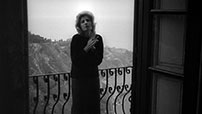
Fig. 7: Claudia on the porch outside the hotel room in Taormina. |
|
| |
Anna was a potential Expressionist protagonist whom Antonioni discarded. Penelope Houston has rightly described her as having “a neurotic urge to put herself at the center of every stage” (Antonioni 1969: 256). She is a wild, even dangerous, figure whose discontent with life and uneasiness in her love for Sandro manifest themselves at every turn. Like many German Expressionist protagonists, she has difficulty communicating with her father. She is destroyed, or disappears, before any transformation can take place in her. Antonioni seems not to share the Expressionist faith in the ability of the hero to transform his society and himself through verbal and physical violence, so he gets rid of Anna. By the end of L’avventura, Claudia has the knowledge about Sandro and his social class that Anna took with her when she disappeared. She gives her pity to the unfaithful Sandro; and in not running away from him on the terrace, she acts willfully against all that she knows about him. She remains, in gentleness and silence, with her hand on his head in the final shot of the film (fig. 8).
L’avventura, Social Class, and Michelangelo Antonioni
L’avventura is, I believe, less an indictment of a social class, as a number of its original reviewers maintained, than a chronicling of an outsider’s initiation into it. (See the original reviews by Ellen Fitzpatrick in Films in Review, May 1961; Gordon Gow in Films and Filming, January 1961; Andrew Sarris in The Village Voice, March 23, 1961; Pauline Kael in her 1965 book I Lost It at the Movies; and by Dwight Macdonald in his 1969 book On Movies.) Instead of destroying this social class in ecstasy from within, in the manner of the German Expressionist heroes, Claudia attempts to alleviate its distress, through compassion, from without. She is a “new woman” wedded spiritually to an “old man” at the end of the film. We have long since left all the couples in whose lovelessness and disquiet Sandro shared. It is up to Claudia and the tearful Sandro, in “shared pity,” to use Antonioni’s words (quoted in Sandall, 54), to create a vital and stable order. The rich are a given in this film: they are here, they will always be here, and they are not condemned simply for being rich. What becomes of the lives of the rich is another question, one that concerns Antonioni.
Like Anna, the director was an outsider in his own upper class: he voluntarily exiled himself at age twenty-seven from the world of his father, a wealthy businessman, and went to live in Rome, where at times he almost starved in order to establish his independence. Before shooting his first feature, Cronaca di un amore (Story of a Love Affair, 1950), he made documentaries that depicted the lower class such as Gente del Po (People of the Po, 1947), about Po River fishermen, and N.U.: Nettezza urbana (Department of Sanitation, 1948), about the street cleaners of Rome. With Cronaca di un amore he began a series of films about lower-class characters in a world of luxury, returning once to an actual working-class milieu in Il Grido (The Outcry, a.k.a. The Cry, 1957). This series culminated in L’avventura, with its outsider Claudia from the middle class. Finally, with La Notte and L’eclisse, Antonioni was completely at home in the world of the upper class, no longer needing to employ an outsider as his window on it. (Nonetheless, L’avventura, La Notte, and L’eclisse are related in an indestructible unity: in the first, we move through landscapes, bare islands, the sea, or through nature and whitewashed ancient towns that seem to be part of nature; in the latter two films, we move through the city [Rome, rather than Milan, in L’eclisse], with its geometry of streets and its assembly of artifacts, the coldest products of modern materialistic inventiveness, the new nature of which Antonioni’s characters would become the explorers - and the exhibited sacrifices.) |
|

Fig. 8: Claudia’s gesture is emphasized by the underscore music. This is the second to last shot of the film. |
|
| |
It is as if, once he reentered prominent social circles through his directorial renown after L’avventura, Antonioni decided to stay and take an unmediated look around, just as his own character Claudia did after her entry into the same circles through her beauty and grace (fig. 9). In this Antonioni is not unlike Federico Fellini, who, originally from the provincial middle class, made films about it and about the lower class until his reputation gained him entrance into high society. But Fellini seemed to take the view of a boy at play in a new, if jaded environment, while Antonioni assumed the attitude of a man returning deliberately to the home he had deserted. That is, where Fellini examined with quasi-expressionistic ebullience and indulgence the moral and spiritual inertia of the upper class, beginning with La dolce vita in 1960, Antonioni did so like the introspective realist he was becoming: with austerity and concern.
Claudia as Outsider or Observer
Monica Vitti, as Claudia, is less a straightforward “objective” character whose character or self Antonioni studies and with whom the audience may empathize, than she is a figure identified with the director-as-beholder behind the camera, whose gaze she doubles like an Expressionistic heroine. She is therefore as much beholding as beheld, in contradistinction to Laura Mulvey and other proponents of male-gaze theory, who see Vitti and beautiful female characters like her solely as passive objectifications of masculine sexual fantasy. Antonioni’s tendency to filter our perceptions through the perspective of a woman was already manifest in such accomplished early works of his as La signora senza camelie (The Lady without Camelias, 1953) and Le amiche (The Girlfriends, 1955). But it reaches a culmination in his films with Vitti, which display a peculiar intimacy between director and actress (similar in some ways to that between Godard and Karina and no doubt in both cases having something to do with the fact that director and actress were intimate in real life). The distinctive interrogative gaze of Antonioni’s camera is thus paralleled by the gaze of Vitti’s major characters in his films—Vittoria in L’eclisse, Giuliana in Il deserto rosso, and, perhaps above all, Claudia in L’avventura. (See the descriptions, at the close of this essay, of the various shots in L’avventura in which the gaze of Claudia/Vitti is featured.)
Monica Vitti may well be described as an actress of the gaze, both the gaze she turns on the world and the gaze the world turns on her. Every performer, of course, is there to be looked at, on display before an audience of voyeurs, if you will. But just as Antonioni’s films enact a special way of looking, so too does Vitti’s special quality as a performer arise from the way in which she looks at things, as well as the way she is looked at and aware of being looked at: in a word, from the interplay between her as the subject and the object of the gaze. Thus does Vitti ever remind us of Antonioni’s special mission in his films that feature her: to strike a balance, with what I have termed “introspective realism,” between the extreme subjectivity of “mystical” expressionism, on the one hand, and the extreme objectivity of “scientific” realism, on the other.
Perhaps no sequence in L’avventura exemplifies this balance or bridge between the empirical and the essential more than the one in which Claudia - a distant relative of the figure in Edvard Munch’s expressionistic painting The Scream (1893) - runs frantically through the long corridors of a Taormina hotel (fig. 10) and continues running once she leaves the building, as Antonioni’s camera intently gazes upon her, and the scene, the whole time. In reality she has been searching for Sandro; in fact she found him in the hotel, with another woman. In terms of inner or “higher” truth, however, Claudia is on a lone, and increasingly desperate, search for psychic self-and-salvation, and it is her gaze, finally, that reveals this to us. |
|
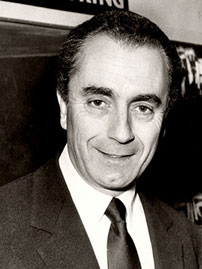
Fig. 9: Michelangelo Antonioni.
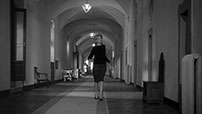
Fig. 10: Claudia searching for Sandro at the hotel in Taormina.
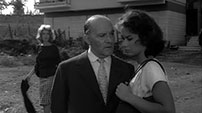
Fig. 11: Claudia observes the conversation between Anna and her father in the first scene of the film.
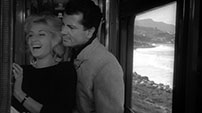
Fig. 12: Claudia, joined by Sandro, observes the flirtation in the train compartment.
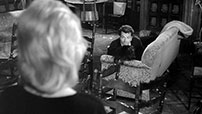
Fig. 13: Claudia finds Sandro making love to Gloria Perkins on a couch in the hotel lounge. |
|
 |
 |
 |
 |
 |
|
 |
 |
 |
| |
Facts
Appendix: Shot Descriptions of Claudia as Outsider or Observer
- Claudia observes the conversation between Anna and her father, outside Anna and her father’s house. (See the still in L’avventura, A Film by Michelangelo Antonioni [Grove Press], p. 12.) (fig. 11)
- Claudia waits impatiently outside Sandro’s apartment as he and Anna have sexual intercourse inside. (See pp. 15, 16, and 18 of the Grove Press screenplay.)
- Claudia enters an art gallery and observes first an American couple, then two workers discussing paintings. (See the still, p. 17 of the Grove Press screenplay.)
- Claudia, in the foreground on the yacht, witnesses this typical exchange between Giulia and Corrado:
Giulia: All these islands . . . were once volcanoes.
Corrado: There musn’t be a single fact you don’t know about third grade geography. (See pp. 22-23 of the Grove Press screenplay. Also, see the still of Claudia observing Giulia and Corrado on the island in Screenplays of Michelangelo Antonioni [Orion Press], p. 120.)
- Claudia observes Raimondo’s flirtation with Patrizia on the yacht. (See the still, p. 32 of the Grove Press screenplay.)
- Claudia stands in the foreground as Corrado, Sandro, Raimondo, Patrizia, and Giulia stand behind her: Claudia has decided to remain on the island with Sandro and Corrado while the others go for help. (See pp. 44-45 of the Grove Press screenplay.)
- Sandro walks toward the old man, the single person living on the island (in a hut). In the background, Claudia watches. (See p. 50 of the Grove Press screenplay.)
- Claudia walks silently past Raimondo, Patrizia, Corrado, Giulia, and a diver. Raimondo turns to look at her and drops the vase. (See p. 55 of the Grove Press screenplay.)
- Claudia observes Sandro’s conversation with Anna’s father on the island. (See p. 58 of the Grove Press screenplay.)
- Raimondo, Patrizia, Corrado, and Giulia make their way down the rocks to leave the island. Claudia stands looking out to sea, away from the others. (See p. 61 of the Grove Press screenplay.)
- Claudia, later joined by Sandro, observes the flirtation between the young man and the young woman on the train. (See the still, p. 71 of the Grove Press screenplay.) (fig. 12))
- In the background at the Princess’s villa, Claudia is standing facing away from Ettore (the Princess’s husband), Corrado, Patrizia (the Princess), and Giulia, who speak of Sandro. (See p. 80 of the Grove Press screenplay.)
- At the Princess’s villa, Claudia is in the foreground, her back to the rest, very unhappy at the suggestion that Sandro has found Anna. Ettore, Corrado, and Giulia are behind her. (See the still, p. 80 of the Grove Press screenplay.)
- At the Princess’s villa, Claudia watches Giulia take Goffredo’s arm and walk off with him. (See the still, p. 82 of the Grove Press screenplay.)
- From the terrace outside her room at the Princess’s villa, Claudia observes Giulia and Goffredo walk by below. Giulia can be overheard saying, “May I see your work? I admit, I’m curious.” (See p. 83 of the Grove Press screenplay.)
- Claudia observes Giulia and Goffredo on the stairs. (See p. 84 of the Grove Press screenplay.)
- In Goffredo’s art studio, Claudia comes into the foreground and watches him grabbing Giulia and forcing her backward onto a table. (Claudia has been observing their flirtation since she entered the studio; see the still, p. 88 of the Grove Press screenplay.)
- Claudia watches Patrizia, Ettore, Giulia, Goffredo, and Corrado get into a car and go to a cocktail party. In the foreground, Claudia walks slowly back into the house. (See p. 91 of the Grove Press screenplay.)
- In Troina, Claudia, with Sandro, observes the rift between the druggist and his wife. (See p. 94 of the Grove Press screenplay.)
- In Noto, Claudia regards groups of men who lounge about on the street and on the stairway above, staring at her greedily. She walks across the square, attracting more attention, aware of the eyes upon her and of the comments. Further above, on a balcony, men eagerly move to the railing to watch. (See the still, p. 103 of the Grove Press screenplay.)
- Claudia, alone in the lobby of the expensive hotel in Taormina, looks around at the many well-dressed people wandering about. (See p. 120 of the Grove Press screenplay.)
- Claudia races through the halls of the hotel looking for Sandro, then runs away from him and Gloria Perkins. (See pp. 130, 132, 135, and 136 of the Grove Press screenplay. Also, see the stills, pp. 202 and 205 of the Orion Press screenplay.)
- (Connected with No. 22) Claudia finds Sandro making love to Gloria Perkins on a couch in the hotel lounge. (See the stills, pp. 133-135 of the Grove Press screenplay.) (fig. 13)
- On the terrace of the hotel, Sandro sits on a bench with his back to Claudia, who looks at him. She very slowly moves to him, coming up behind the bench. (See the still, pp. 138-139 of the Grove Press screenplay.
Works Cited and Consulted: Michelangelo Antonioni and L’avventura
Antonioni, Michelangelo. Screenplays of Michelangelo Antonioni. Trans. Louis Brigante and Roger T. Moore. New York: Orion Press, 1963.
----------. L’avventura, A Film by Michelangelo Antonioni. Trans. Jon Swan. Text Reconstruction by David Denby. New York: Grove Press, 1969.
----------. The Architecture of Vision: Writings and Interviews on Cinema. Ed. Carlo di Carlo and Giorgio Tinazzi. New York: Marsilio, 1996.
----------. Michelangelo Antonioni: Interviews. Ed. Bert Cardullo. Jackson: University Press of Mississippi, 2008.
Arrowsmith, William. Antonioni: The Poet of Images. New York: Oxford University Press, 1995.
Battistini, Angelo. “Uneasy Love: Sentimental Diseases and Crisis of the Couple in Antonioni’s Movies.” Psychoanalytic Inquiry, 27.4 (September-October 2007): 504-509.
Bohne, Luciana. “The Discourse of Narcissism in L’avventura.” Film Criticism, 9.1 (Fall 1984): 17-24.
Brunette, Peter. The Films of Michelangelo Antonioni. New York: Cambridge University Press, 1998.
Cameron, Ian, and Robin Wood. Antonioni. Rev. ed. New York: Praeger 1971.
Chatman, Seymour. Antonioni, or The Surface of the World. Berkeley: University of California Press, 1985.
----------, and Guido Frank, eds. L’avventura: Michelangelo Antonioni, Director. New Brunswick, New Jersey: Rutgers University Press, New Jersey, 1989.
---------- and Duncan, Paul, eds. Michelangelo Antonioni: The Complete Films, London: Taschen, 2004.
Cook, David A. A History of Narrative Film, 4th ed. New York: W. W. Norton, 2004.
Cowie, Peter. Antonioni, Bergman, Resnais. London: Tantivy, 1963.
Forgacs, David. “Antonioni: Space, Place, Sexuality.” In Spaces in European Cinema. Ed. Myrto Konstantarakos. Exeter, England: Intellect Books, 2000. 101-111.
Joyce, James. Ulysses. Paris: Sylvia Beach, 1922.
Leprohon, Pierre. Michelangelo Antonioni: The Man and His Work. Trans. Scott Sullivan.New York: Simon and Schuster, 1963.
Lyons, Robert Joseph. Michelangelo Antonioni's Neo-realism: A World View. New York: Arno Press, 1976.
Moore, Kevin Z. “Eclipsing the Commonplace: The Logic of Alienation in Antonioni’s Cinema.” Film Quarterly, 48.4 (1995): 22-34.
Mulvey, Laura. ‘”Visual Pleasure and Narrative Cinema.” Screen, 16.3 (Autumn 1975): 5-17.
Nowell-Smith, Geoffrey. L’avventura. London: British Film Institute, 1997.
Núñez-Fernández, Lupe. “Antonioni’s Gaze.” Flash Art,40 (October 2007): 65, 74.
Orban, Clara. “Antonioni’s Women, Lost in the City.” Modern Language Studies, 31.2 (Fall 2001): 11-27.
Perry, Ted, and René Prieto. Michelangelo Antonioni: A Guide to Reference and Resources. Boston, Massachusetts: G.K. Hall, 1986.
Rifkin, Ned. Antonioni’s Visual Language. Ann Arbor, Michigan: UMI Research Press, 1982.
Ritchie, J. M. German Expressionist Drama. Boston: Twayne, 1976.
Rohdie, Sam. Antonioni. London: British Film Institute, 1990.
Rosenbaum, Jonathan. “A Cinema of Uncertainty: Films by Michelangelo Antonioni.” In Rosenbaum’s Placing Movies: The Practice of Film Criticism. Berkeley: University of California Press, 1995. 307-321.
Rudman, Mark. “The Night: On Michelangelo Antonioni.” Raritan, 14.2 (Fall 1994): 83-108.
Sandall, Roger. “L’avventura.” Film Quarterly, 14.4 (Summer 1961): 51-54.
Schwarzer, Mitchell. “The Consuming Landscape: Architecture in the Films of Michelangelo Antonioni.” In Architecture and Film. Ed. Mark Lamster. New York: Princeton Architectural Press, 2000. 196-215.
Tomasulo, Frank P. “The Rhetoric of Anti-Closure: Michelangelo Antonioni and the Open Ending.” Purdue Film Studies Annual (1983): 133-139.
----------. “The Architectonics of Alienation: Antonioni’s Edifice Complex.” Wide Angle,15.3 (July 1993): 3-20. |
|
|
|
|
 |
 |
 |
 |
16:9 - april 2013 - 11. årgang - nummer 50
Udgives med støtte fra Det Danske Filminstitut samt Kulturministeriets bevilling til almenkulturelle tidsskrifter.
ISSN: 1603-5194. Copyright © 2002-13. Alle rettigheder reserveret. |
11 |
|
|
 |
 |
|
|